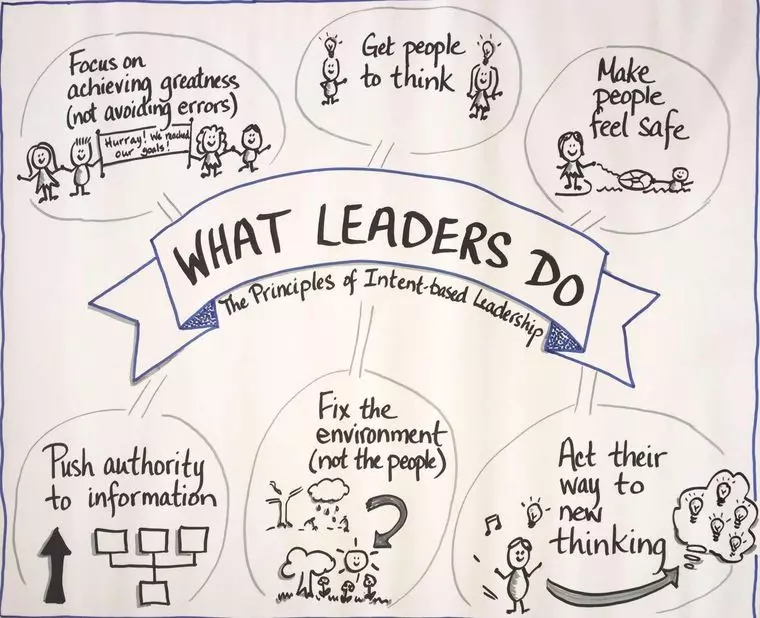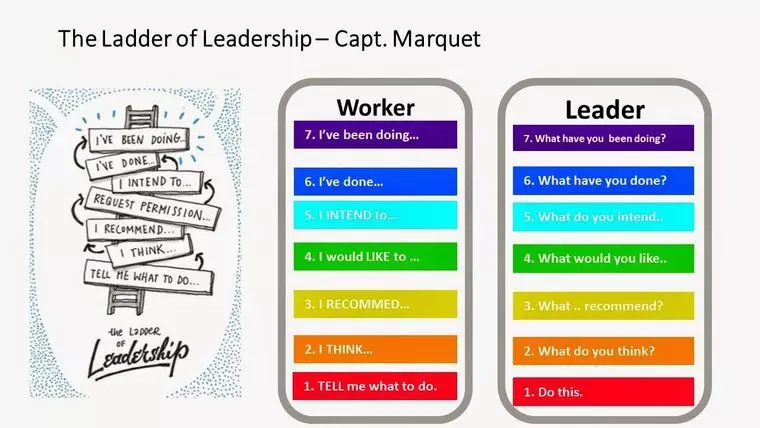What needs to be done so that team members, in the company, can fully focus on the project to achieve the highest productivity?
The “old-fashioned” leader assumes that a successful organization is led by a person on the TOP who is an excellent person who knows and understands everything, who will lead them to success.
But is this approach enough to inspire, or make each member burn with the work they are doing? Then the “usually no” answer.
Intent-based Leadership
Purpose-based leadership is another approach where we create an environment where your project team is encouraged to contribute ideas and feel valued when doing so.
There is a safe environment built on trust – where members feel motivated and inspired to do great work. And there the control, the decision power, is given to no one else – the team members themselves.

An “old-fashioned” leader would probably be scared or not even thinking of “giving up control” to giving it to others. It sounds “funny” because that is how to lead a team, it sounds like you deny the most important task of a leader.
But the truth is that if you want to be an effective leader, you need to empower .
If you want to be an effective leader, you need to empower
Giving up the right to decide, what members always expect you to do, helps members to “stretch” a little, and practice adapting to the situation. Giving others the decision-making power they’d normally expect you to make, helps them stretch themselves and practice
If you learn to accept these “seemingly strange” things, you will learn how to empower and be able to sleep well because you know and believe that your brothers are equipped and ready to deliver. Decide to handle the job properly. Because leaders empower to create leadership
Leaders empower to create leadership
It sounds nice, but how can we apply it to our organization?
Here are a few ways you can try it out ~
Giving more control
The first thing you can do is change your language.
For example, suppose a member comes to you and asks “hey what should I do?” then try to refrain from giving a solution, but instead, ask again: “So you try to think about what you should do?”
This method “transmits the ball” to the member, causing the person to use his or her judgment to develop leadership skills.
You can judge that a person is on the leadership ladder by collating the questions below. Try to see which members of your project team belong!

Let the team members “disagree”. For example, in a regular meeting, if you want your brothers and sisters to really express their thoughts, then ask them to speak their opinions first. Listen actively and ask questions – before giving your thoughts. When giving a task, specify the purpose – not the plan.
When giving a task, specify the purpose – not the plan.
Encourage self-discipline
Once the decision-making authority is exercised widely, technical competence becomes an important issue now. Don’t just tell them what they need to do, remind them to study, so they can afford to make decisions even when you’re not there.
It is not necessary to register for you expensive courses, but here we how to build a culture where learning takes place everywhere, anytime.
Guiding principles for decision making
Instead of “rigid” processes, help team members understand the methodologies and principles needed through instructions (possibly in writing) so members really understand. the nature of the goals of what you do and can create your own flexible implementation options with situations based on guided arguments.
For example, a guide on “defining what is done” (definition of done) instead of a checklist in which exact testcase requirements must be 100% covered (the goal of each project development stage can be different, so we don’t always need to be 100% perfect)
Building trust
Listen first, say last. Get to know the members and make a connection with everyone. Do not sit in your place; make people approach you; Sit beside your fellow project comrades; Go out and dine with them, talk on the sidelines outside the work.
In addition, by directly participating and helping a part of the project brothers’ work, you will better understand the difficulties that you face. This will help you build empathy and trust in the team.
Listen first, say last
Recognition
You want an environment in which you aspire to seek excellence, not hesitate to make mistakes.
If a member does an excellent job. Don’t wait until your review quarterly or every few months to praise the member, but tell the person right now .
Give them recognition from your side, the company immediately, and be specific.
This open and immediate employment will create a great source of encouragement not only for the individual, but also create momentum for the longing spirit of all the other project / company members.
Speak up
The more members who are empowered to make decisions – the more comfortable they are to choose the way they want it, the harder it will be for others, or how much control we can take over it.
At this point “transparency” is the key; No need for a complicated channeling process, simply a quick message on Slack notify to enter the channel of the entire team – is enough.
For example, an Infra friend fixes a piece of environment setting, just he pings on Slack about to do something, and continuing a notice of completion will help the whole team understand this.
Another example of deployment on production. You can create a guide about what it means to be a successful release , a document that again “transparency” is a big requirement for members when deploying a deployment. The document requires technicians to be clear about the intent of the release, compose the content of the release function and provide the status of the release. So you just need to ensure the above criteria, you can have full autonomy when you can release.
summary
A leader who empowers his team members is not a person who gives up his duties, but that is actually the most important responsibility of a leader. It is an important task in developing and fostering the “human” element in the organization.
There will come a time when we will not see much improvement or efficiency from this “intentional leadership” approach, but let’s continue! Repeating your messages in messages, emails, meetings, on chatwork, slack … trust the good things that will happen.
Remember – Leadership is an option, not a position
Leadership is an option, not a position.
